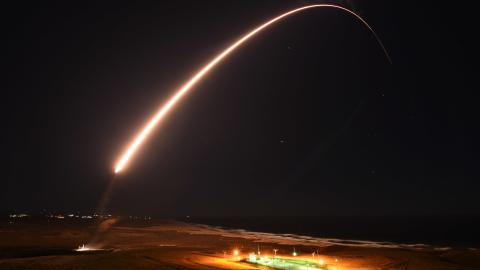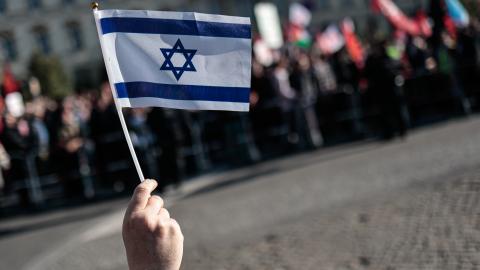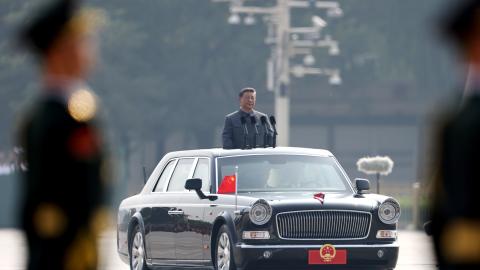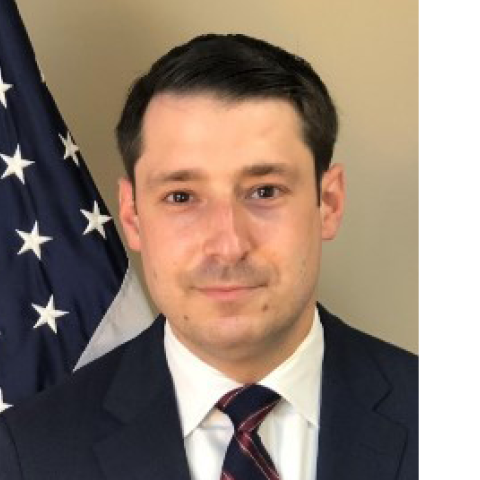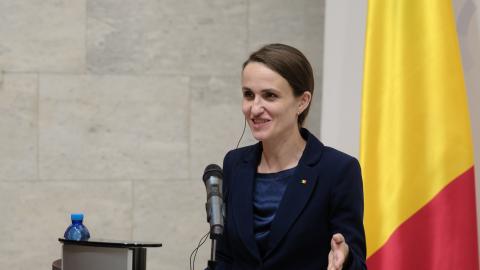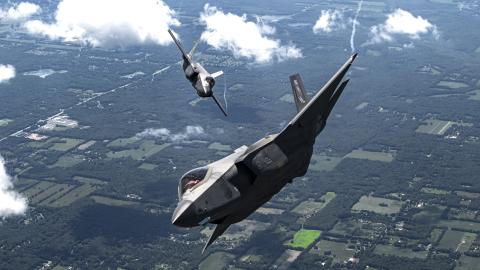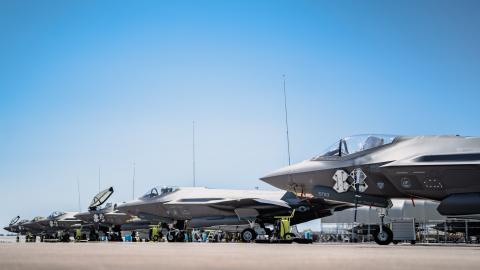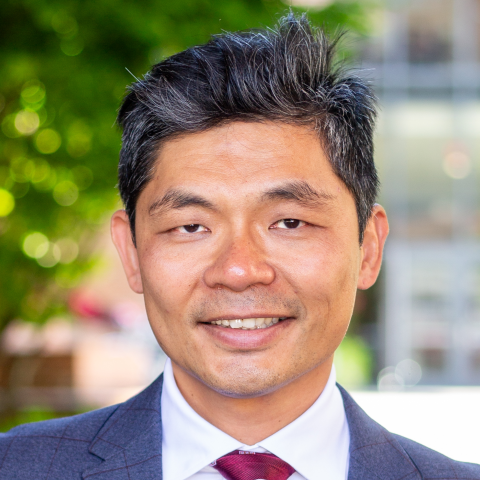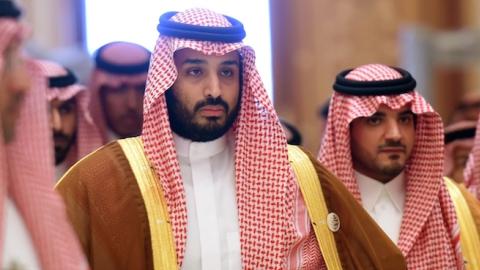Abstract
Saudi Arabia's announcement of the formation of an 'Islamic Alliance' to combat terrorism in mid-December 2015 incurred the concern of Abu Bakr al-Baghdadi, the 'caliph' of the Islamic State. His propagandists were unprepared to address the ideological ramifications of such a paradigm shift in Saudi behavior. The anti-Saudi ideological formulations and narratives that the jihadists had developed over a number of years did not factor-in the possibility that Saudi state would undertake aggressive military operations beyond its borders, operations directed primarily against themselves. Saudi thinking may be premised on the idea that the Islamic State--seeking local support in Iraq and Syria by claiming to act in defense of Sunnis against tyranny and sectarianism--would crumble easily and quickly if faced with an 'Islamic Alliance' that aims to liberate Sunnis from both the Islamic State and Iranian hegemony alike. The announcement has raised popular expectations of an impending 'new order' in the Middle East among those heartened by what they consider 'long-overdue' Saudi activism. However, the new Saudi initiative is a dangerous gamble that may backfire on rhetorical and ideological grounds if the campaign fails or takes too long.
.................
The jihadists of the Islamic State have had a lot to say about the Kingdom of Saudi Arabia. They do so because they see themselves locked in a rivalry with it. At the heart of the rivalry is the question of who gets to pose as the defender of ‘Sunnidom’ in the face of Iranian expansionism in the Middle East, a perception both rivals share and agitate over. The Islamic State argued that the House of Saud has lost the legitimacy and efficacy necessary to mount such a civilizational defense. They cited the static nature of Saudi inaction, one that did not correspond to the alarmist rhetoric emanating from Riyadh concerning Shi’a transgressions against Sunnis. The jihadists may believe that this disconnect between rhetoric and action is accelerating the disaffection of Saudi citizens with their rulers. They may hope that this disaffection would welcome the expansion of the Islamic State into the Saudi heartland—a goal that is critical to the long-term survival of their state, or so they may believe.
However, Saudi Arabia’s regional policy is no longer static. A year ago, the Saudi state launched a military operation in Yemen against rebels it deemed beholden to Iran. The jihadists responded with disdain and mockery. They assumed that it was a fluke occurrence and that the war would expose Saudi feebleness and irresolution. Yet in December 2015, the Saudi state went further and declared the formation of an Islamic military alliance to combat terrorism. The implication was that Saudi Arabia is willing to take the battle to the jihadists in Syria and elsewhere. The move was also widely interpreted by Middle Eastern observers in media and intelligence circles as one that seeks to counterbalance Iranian activism across the Middle East. One Saudi-focused analyst wondered whether it constitutes the formation of an Islamic equivalent to the North Atlantic Treaty Organization (NATO).1 This latter perception has seeped into the public debate across the region, raising expectations of a “new order.”
The jihadists were not prepared to consider the possibility of such an unprecedented paradigm shift in Saudi behavior when they first analyzed the Yemen campaign. Their anti-Saudi narrative was tailored to address and belittle Saudi inaction, and now it must play catch up to Saudi action. They must also address the ideological ramifications of the kingdom positioning itself as a “warrior state,” harking back to a centuries-old identity that it used to manifest prior to its founding in 1932. The rhetorical arsenal that the jihadists had developed and deployed in previous years is ideologically insufficient to counter a rival warrior state, especially if it is Saudi Arabia. Now they will have to contend with the possibility that Saudi Arabia’s new expansionist policies may be well-received by its citizens, whom the jihadists were hoping to recruit and incorporate into their own expansionist state. The jihadists must now argue that Saudi action is illegitimate. That is a harder argument to make compared with one centered on Saudi torpor since the Saudis are doing precisely what jihadists for years have criticized the Saudis for not doing. It is especially harder should Saudi action lead to a radical rearrangement in the balance of power in the Middle East. As such, ideology follows action, and the jihadists were caught by surprise, at least for now. But the Islamic State could possibly find its footing if or when the Saudi-led Islamic Alliance fumbles on the terrain of battle or even if it fails to launch at all and falls short of meeting the expectations it has raised. Saudi Arabia may have felt compelled to take such a gamble, given what the jihadists were saying about its inactivity and other internal socioeconomic and cultural challenges at play. But it is a dangerous gamble nonetheless. If the Islamic Alliance ends up perceived by Saudi citizens to be a failure, then that perception may accelerate the loss of the regime’s cache of legitimacy. The jihadists may then spot an opportunity to gain ground within the kingdom, directing more of their personnel, resources, and propagandist attention toward that goal.
THE ISLAMIC STATE’S SAUDI POLICY AS REFLECTED IN AL-BAGHDADI’S SPEECHES
Islamic State leader Abu Bakr al-Baghdadi has delivered three ‘policy’ speeches since the declaration of the caliphate in September 2014. The Islamic State’s media organs released the first speech as an audio file in November 2014, followed by two more in May and December 2015. Saudi Arabia figures prominently—one can even argue, predominantly—in these speeches. Clearly, the Islamic State’s foreign policy, to the extent that it is a state, is fixated on the country to its south. Al-Baghdadi does not seem to envisage revolution in Saudi Arabia; what he promises is an outright invasion, or rather, in his mind, a “liberation” involving the expansion of his state to incorporate proto-revolutionary population centers within Saudi Arabia that would welcome his fighters. The Islamic State had heralded the establishment of three wilayats (provinces) in Saudi Arabia (Hijaz, Najd and al-Bahrain), which may seem to indicate a policy of fomenting revolution or at least securing territorial control from within. But al-Baghdadi’s first two speeches suggest a preference for a policy of expansion of his state southwards at some time in the future. At present, the Islamic State de facto shares a border with Saudi Arabia running along its Wilayat al-Anbar and what was previously, at least in its eyes, the former Iraqi-Saudi border. The Islamic State has tried to expose this reality by releasing videos of its militants attacking Saudi and Iraqi police forts on either side of the border.2
However, there was a transition in al-Baghdadi’s Saudi policy across the span of his three speeches. The speeches began as instructive to his sympathizers within Saudi Arabia. They soon changed into a reactive tone—reacting to the dramatic changes in Saudi Arabia’s own foreign policy.
In his first speech as caliph in November 2014,3 al-Baghdadi prescribes a ‘to-do list’ for his supporters inside the kingdom. Essentially, al-Baghdadi calls for a violent campaign inside Saudi Arabia to distract the Saudi government away from attacking the Islamic State. He calls for targeting Saudi Shi’as as well as members of the Saudi royal family. At that point, al-Baghdadi was evidently concerned by the airstrikes that Saudi Air Force pilots, along with their peers from other Persian Gulf states, had been conducting against Islamic State targets in Syria in concert with the international coalition. He claimed that his strategy of drawing the Americans into a ground war was progressing well. His evident goal was to deny American forces the legitimizing cover provided by the participation of Muslim forces, such as the Saudi pilots, in their coalition. Al-Baghdadi promised his supporters in Saudi Arabia that the “vanguard of the Islamic State” would soon arrive inside the kingdom. His second foreign policy focus concerned Yemen’s Houthi rebels, promising that the Islamic State’s soldiers will fight them there. Al-Baghdadi’s overarching message was that his caliphate was the only force actively and successfully confronting Shi’a Iran’s expansionist policies in the Middle East, while the traditional Sunni powers, namely Saudi Arabia, were asleep at the wheel.
By his second speech,4 al-Baghdadi was compelled to address a momentous change in Saudi’s foreign policy, specifically as it relates to Yemen. His deportment, although reactive, was one of taunting rather than alarm. Al-Baghdadi addresses the Saudi military campaign against the Houthis in Yemen, what the Saudis call the “Storm of Decisiveness” launched in March 2015, by suggesting that the House of Saud does not have the stomach for war. This showy military adventure, he argues, will come to nothing. He also indicates that he believes that the Saudis launched their campaign to steal a march on the Islamic State’s own narrative and actions:
“For it is only a ‘storm of delusion’ after the fires of the [Shi’as] had lapped at their thrones and their encroachment has reached our people in the Arabian Peninsula, which will lead lay Muslims to find refuge in the Islamic State because it is their defender, and this terrifies the [House of Saud] and the rulers of the Arabian Peninsula and shakes their bastions and that is the secret of their alleged ‘storm’ and, God willing, it shall be the [cause of their] demise. For the [House of Saud] and the rulers of the Arabian Peninsula are not people of warfare, and they do not have the patience for it, and they are people of luxury and frivolity, and people of drunkenness and dancing and banquets, who have acquiesced to the protection afforded to them by the Jews and Crusaders…”
Leading up to this taunt, al-Baghdadi questions why the House of Saud has spent so much money on its military but failed to defend other Muslim communities in the past. He lists past and contemporary conflicts in Iraq, Syria, Burma, China, India, Indonesia, the Caucuses, Africa, Palestine, and Afghanistan (referred to as ‘Khurasan’). Al-Baghdadi analyzes the turn in Saudi policy by arguing that the Saudi royals, after having long served their “masters the Jews and the Crusaders,” now find themselves cast away by the latter. Instead, Shi’as and the Kurds have become the reliable lackeys of Western powers in the Middle East. Thus, al-Baghdadi’s reading of the Saudi decision to fight in Yemen is that it is a futile “gasp of death” in a bid to make themselves relevant again to their “masters.” He goes on to question why they would fight only in Yemen and not in Syria, where the Alawites were persecuting and murdering Sunnis. Al-Baghdadi would revisit this rhetoric in his third speech, after it became clear to him that the Saudi shift demonstrated in Yemen was not a one-off event, but rather the beginning of a dramatic Saudi foreign policy re-alignment. Al-Baghdadi had to react to the prospect of the Saudis not only having the stomach to fight after all, but also a willingness to come after his state in Syria and possibly Iraq.
Al-Baghdadi targeted his third speech5 on Saudi Arabia’s announcement of an Islamic Alliance to combat terrorism. The announcement was made in Riyadh on December 14, 2015, by Deputy Crown Prince and Minister of Defense Muhammed bin Salman. Al-Baghdadi revisits his point about the reluctance of Western powers to come fight the Islamic State directly. While previously they relied on local actors such as the Shi’as and the Kurds to do so, the new Islamic Alliance was the culmination of their approach.6 Al-Baghdadi says:
Here we have the [Christians] Crusaders and the nations of unbelief and the sects that follow them, and those who are backed by the Jews, not daring to come on the ground to fight the small band of mujaheddin, and each pushes his partner to go first to embroil him, for their hearts are filled with terror [from confronting] the mujaheddin, because by the grace of Allah they had been chastened in Afghanistan and Iraq, and they know they do not have the energy [to confront] the mujaheddin. They do not come because they verily know what awaits them by way of predicaments and laments, in [Syria] and Iraq and Libya and Afghanistan and Sinai and Africa and Yemen and Somalia. They know what awaits them in Dabiq and al-Ghouta by way of defeat and exhaustion and destruction, and they know that it is the final battle. And after that, Allah willing, we shall raid them rather than them raiding us, and Islam will reign over the world again, until the end of times. That is why they delay coming [at us] in any way they can, and they work hard to mobilize more of their acolytes and agents, from the awakening [groups] and the apostates and atheist Kurds, and the hordes of [Shi’a] cattle, for America and its allies still dream of putting an end to the caliphate through their agents and acolytes, and every time one of their coalitions fails or one of [their] tails is cut, they rush to create another, until they declared recently [the formation of] the [Saudi] alliance that is fraudulently called ‘Islamic’, which has declared that its goal is to fight the caliphate. If it were an Islamic alliance then it would declare its support and relief to the oppressed and dispossessed people of [Syria], and would declare war on the [Alawites] and their masters the Russians. If it were Islamic then it would declare its enmity and war on the polytheist [Shi’a] and the atheist Kurds in Iraq, who have killed and dispossessed the Sunnis and ravaged their lands. If it were an Islamic alliance then atheist China would not have supported it and asked to join it.7 If it were an Islamic alliance then it would have dissociated from its masters the Jews and the Crusaders, and would have set its goal to fight the Jews and liberate Palestine.8
The tone of al-Baghdadi in his third speech is markedly different. He no longer taunts the Saudi royals as docile and decadent. His tone is somber and cautious, even alarmist. He goes on to call upon the Muslims of the world and implores them to “realize that the Islamic State, since its foundation ten years ago,9 has been the spearhead in the war between the realm of belief and the realm of disbelief.” He adds that the unity of all these myriad forces arrayed against the Islamic State confirms that it stands in the right. Rather than asking his supporters in Saudi Arabia to wage a campaign of distraction and to await the vanguard of his fighters from the north as he had done more than a year earlier, he now asks them to rise up against the House of Saud. Al-Baghdadi turns pensive and repeats the earlier allusion about the 10 years that have passed since the Islamic State’s founding to suggest that the jihadists had endured tribulations before when the Islamic State enterprise was considered all but finished. Al-Baghdadi’s shift in tone indicates that at least he and his advisers are taking the new Saudi initiative seriously.
Notwithstanding the obvious reasons he should do so—the prospect of well-trained and well-armed Muslim militaries attacking his territory—the “caliph” may be worried about the ideological implications of this initiative and whether it must compel the Islamic State to reconsider its messaging to the Saudi populace. For a number of years, the Islamic State had homed in on a particular set of narratives for a Saudi audience, but the current changes in the behavior of Saudi Arabia’s leadership may render those narratives outdated and ineffective.
THE ‘OLD’ NARRATIVE: THE “OH LAND OF REVELATION, PATIENCE” MEDIA BUNDLE
Before embarking on an exploration of al-Baghdadi’s qualms concerning the ideological implications of the Islamic Alliance, we should take a close look at the Islamic State’s most ambitious media campaign against the Saudi state.
A few days before the caliph’s speech, the official media organs of the Islamic State, in coordination with its unofficial media amplifiers (such as al-Battar, al-Sumoud, etc.), released 26 videos and dozens of essays, poems, and posters onto multiple internet platforms. The Islamic State bundled the whole lot in a CD-ROM titled, “Oh land of revelation, patience.”10 The content was a compendium of all the talking points that the Islamic State had employed and developed when addressing an audience in Saudi Arabia. The main feature of the official videos was to highlight the Saudi face of the Islamic State, with short speeches by Saudis fighting for the Islamic State in places such as Iraq, Syria, Yemen, Libya, and Egypt.
The videos and essays contain little new in the Islamic State’s talking points about Saudi Arabia. Most of the themes had been raised throughout the eight decades since the establishment of the kingdom. They harked back to the Ikhwan men ata’ Allah movement of the late 1920s, through the seminal stations of Juheiman al-‘Uteibi’s 1979 Meccan Revolt and Abu Muhammad al-Maqdisi’s influential book, Al-kawashif al-jaliyya fi kuffr al-dawla al-saudiyya (‘The illuminating evidence of the unbelief of the Saudi state’, first edition 1989). They included much of the anti-Saudi jihadist narratives generated since. The ideological trajectory of Abu Musaab al-Zarwaqi on Saudi matters as a result of al-Maqdisi’s influence is well established, which through al-Maqdisi can be traced back to al-‘Uteibi.11 Just as al-Maqdisi went further than al-‘Uteibi in his willingness to castigate the House of Saud as unbelievers and consequently shifted the debate, al-Zarqawi’s break with al-Maqdisi’s influence shows how al-Zarqawi’s heirs—who went on to establish the Islamic State of Iraq in October 2006—placed more emphasis on two of al-Zarqawi’s general non-Saudi specific innovations. They include the fight against the Shi’as and undermining the authority of more learned religious scholars (an innovation al-Zarqawi used against al-Maqdisi at first) as they sharpened their rhetorical attack against Saudi Arabia. The ideologues of the Islamic State were inspired to apply those two innovations to the Saudi context to warn of the Shi’a danger within Saudi Arabia in addition to their attempt to undermine the traditional Wahhabi establishment in the kingdom.
The general anti-Saudi themes dwelt upon in the media bundle are: neglecting the practice of al-wala’ wel bara’ (‘loyalty and renunciation’); accepting man-made legislation and authority such as the United Nations charter; enacting regulations that contradict the shariah; allowing business transactions such as usury and interest in the banking sector; hosting religious dialogue conferences and conferences on anti-terrorism that aimed at the mujaheddin; allowing polytheists—specifically the Shi’as—to perform their rites openly in the Arabian Peninsula, even in the Holy Sanctuaries of Mecca and Medina; being agents of the Crusaders; employing pliant religious clerics to legitimize their tyranny; and fighting other Muslims and incarcerating jihadists as part of the international coalition. All these themes have been amply discussed in the field of jihadist studies. The only novel theme highlighted in the media bundle was the issue of female prisoners being held by the Saudi authorities, but the emphasis there seems to do more with tribal honor rather than with ideology.12 Interestingly, only one of the videos dwells on the changing socio-economic and cultural dynamics within the kingdom. However, the Islamic State’s reluctance to address such issues could be attributed to its unwillingness to hold up its own record of governance, given its constraints under a war economy, which may not reflect well in comparison with the House of Saud’s economic policies.
The Islamic State had been projecting itself as the true inheritor of the first Saudi realm (1744-1818) and the initial Wahhabi mission in Najd. It culled religious arguments made during the second Saudi realm (1824-91) to underline its legitimacy. They were doing so specifically for a Saudi audience13 and have been doing it for some time. There are several references made in the “Oh land of revelation, patience” bundle suggesting that had Muhammad b. ‘Abdul-Wahhab and Muhammad b. Saud been alive today, they would have fought against their scions who are presently the inheritors of the third Saudi realm (1902-present). There are also numerous references and allusions to Ibn Abdul-Wahhab’s essay, the 10 nawaqith (‘nullifications’) of Islam to demonstrate that by the criteria established by the founding sheikh of Wahhabism, the current Saudi state had fallen into unbelief. Islamic State propagandists handed out as pamphlets in Raqqa in June 2015 about the 10 nawaqith.14 This rhetorical device is partly useful in deflecting the accusations of khawarij and ridda that the Saudi media and the religious establishment had used against the Islamic State, with the implication that traditionalist Ottoman-era bodies had used the same labels against the Wahhabi mission through its many stations.
There is some disagreement between Western scholars who had studied earlier waves of Saudi jihadists as to the prioritization of their goals and the effectiveness of their narratives. Wagemakers makes a salient case in showing how and why al-Maqdisi’s approach was influential on Al-Qaeda in the Arabian Peninsula (QAP) throughout its violent campaign on Saudi soil (2003-2007). He did so to counter Hegghammer’s neat classification of Saudi jihadists into classical and global categories. Hegghammer used those classifications to explain why the latter model, as represented by the QAP (and inferred from its operational output against Western targets inside Saudi Arabia), failed to gain wider traction within the spectrum of Saudi jihadists.15 The debate between Wagemakers and Hegghammer is relevant to our discussion as to why the Islamic State is still using nearly identical narratives to those of the QAP when they had clearly seen that these narratives had failed to ignite wide support inside Saudi Arabia.
Does the Islamic State believe that what was missing in QAP’s media strategy was an emphasis on issues such as the threat of regional and internal Shi’ism? If so, then the Islamic State’s media strategists would have to contend with the reality that al-Baghdadi’s call in November 2014 for an accelerated campaign against Saudi and Persian Gulf Shi’as had failed to result in the scope of the security disruption he sought. The attacks to date have fallen short of the chaos, and hence the distraction, envisioned. Furthermore, this approach would necessarily compete with the Saudi state’s willingness to take military action against Shi’a encroachment, as demonstrated in Bahrain and in Yemen, in addition to the dramatic step of executing the dissident Saudi Shi’a cleric Nimr al-Nimr. Although the media bundle highlighted al-Nimr’s image several times to give power to its anti-Saudi narrative, it was rendered null as a rallying cry by the Saudi state’s execution al-Nimr for sedition two weeks after the bundle’s release.
One rationale for the Islamic State rehashing the past themes could be that they view it as a matter of timing: jihadist strategists may have determined that the political atmospherics in Saudi Arabia would be ripe for these themes now as opposed to the past. The Islamic State is flush with Saudi recruits who have joined its cause in the last two years. Its strategists may have determined that times have changed through the accounts they heard from the new recruits of the situation back home. The Islamic State may have bet that this time around, the anti-Saudi narrative may succeed in compelling more Saudis to turn against their rulers and its allied religious establishment. If this were indeed the line of thinking, then the media bundle would act as a comprehensive and concise tool to reaffirm the old narrative for new times. It was a virtual free arms market of propaganda that any would-be jihadists could inflict on Saudi Arabia. This opens the debate about whether the inclination for action among young Saudis had changed because the nature of the jihad had changed with its re-emergence in the wars in Iraq and Syria. Given the lack of data, It is hard to gauge how young Saudis perceive these nearby wars, as opposed to the far wars on the periphery of the Islamic world (Afghanistan, Chechnya, and Bosnia, for example) or even the global jihad against the West. Nor is it easy to determine whether we are dealing with a confluence of the classical and global strands. Furthermore, Saudi Arabia’s policy of impeding independent research into such national security avenues, although unhelpful, is understandable given the plethora of Western media critiques that attribute global Islamic radicalization to the Saudis’ long-standing media and educational policies. What we are left with is the attempt to assess how the strategists of the Islamic State understand these internal dynamics given the anecdotal evidence they gather from new Saudi recruits. The emphasis of the Islamic State on Saudi Arabia as an imminent front for its projected expansion throughout the Middle East would suggest that the group believes the receptivity to its narrative theme is high at this time.
WHY IS AL-BAGHDADI CONCERNED BY THE ‘ISLAMIC ALLIANCE’?
Al-Baghdadi’s response to the Islamic Alliance could have centered on his earlier point about the Yemen campaign, that the House of Saud will not have the stomach to follow through. Al-Baghdadi could have mocked the new alliance by citing the flurry of press reports suggesting that many of the militaries listed by Prince Muhammad b. Salman were unaware that they were part of the alliance at the time of its announcement. Al-Baghdadi could have launched an ad hominem attack on the prince himself and his perceived recklessness, inexperience, and arrogance, again by citing press reports to that effect. Al-Baghdadi could have used the occasion of his third speech to reaffirm the themes espoused by the “Oh land of revelation, patience” media bundle to give succor and bite to the overall campaign. But he didn’t. His tone was somber and reflects genuine concern. Given that the ‘on-the-ground’ effects or scope of action of the Islamic Alliance had not materialized by the time of his speech, one can deduce that al-Baghdadi’s principal concern emanated from the ideological implications of Saudi Arabia leading this alliance and how that may affect his state’s anti-Saudi strategy and narrative.
The timing and content of the media bundle and al-Baghdadi’s speech may reflect a re-alignment of the Islamic State’s narrative and plans against Saudi Arabia. An analysis of the videos and essays of the media bundle suggests that work on it began in mid- to late November and was completed and ready for release in mid-December 2015. The Islamic Alliance was announced on December 14. Al-Baghdadi’s speech was released on December 26.
There are only three references made to the Islamic Alliance in the media bundle, and all were made as part of the graphics component, rather than in essays or speeches. The Aleppo wilayet ‘official’ video begins with a graphic highlighting the support for the alliance given by the General Secretariat of the Council of Senior Clerics, the highest religious authority in Saudi Arabia and then by the Organization of Islamic Cooperation. However, the graphic appears independently of what the narrator is saying, suggesting that it was added toward the end of the production process. The second reference in the bundle made to the Islamic Alliance was by the ‘unofficial’ Asawirti Media arm of the Islamic State, again in the form of graphics. The wording of the graphics is interesting as it previews some of how al-Baghdadi was to address the alliance later in his third speech. The ‘unofficial’ video states that “after the failure of the Crusader alliance in confronting the Islamic State, they have come up with a new satanic trick.” It adds that “America commands and the [House of Saud] complies, obediently and submissively” and that it was all “theater.” Asawirti Media then projects still images of Twitter messages made in support of the alliance by pro-regime clerics: Nasir al-Qetami, ‘Ayidh al-Qarni, Muhammad al-Hudheif, and the Council of Senior Clerics. The ‘unofficial’ al-Thabat Media video keeps it brief and simple: the video links the emergence of the Islamic Alliance to an earlier speech made over two years ago by Amos Gilad, the director of the Political-Military Affairs Bureau at Israel’s Defense Ministry, during which he speaks about how a Sunni military axis is a positive development for the stability of Israel.16
The evidence suggests that the Islamic Alliance was announced at the tail-end of the production of the media bundle. By not addressing or highlighting the themes of the media bundle, al-Baghdadi’s speech suggests that the emphasis, at least in his mind, had partly shifted from the themes of the old narrative to a new ideological battlefield as a direct result of a paradigm shift in Saudi behavior. Word may have gotten back to him, from his networks within Saudi Arabia that the regime’s new actions were popular. One can only surmise that al-Baghdadi may have concluded that the Islamic Alliance may have elicited support and excitement from the same demographics and ideological groups that al-Baghdadi was hoping to recruit.
An alternative reading of al-Baghdadi’s tone may conclude that since the Islamic State is making a more profound claim to the caliphate of Muhammad, and hence adopting a grand, quasi-imperial project, its nitpicking of claims to represent a truer version of Wahhabism would seem provincial by comparison. In this light, it would make little sense for al-Baghdadi to constrict his grand vision as addressed to the Muslim world at large by arguing over the pedantic domestic politics of Saudi Arabia. That task would be left to his propagandists as they tailor a Saudi-specific message, one that incorporates such themes as a comparison to the first Saudi-Wahhabi realm.
Likewise, this alternative interpretation of al-Baghdadi’s third speech posits that the announcement of the Islamic Alliance allows him to frame the competition between the Islamic State and its enemies in grander terms. It is one between multiple state actors and his mujaheddin, rather than a competition with the Saudi state alone. The media coup afforded in presenting itself as a foil to one of the world’s petro-powers would be of great value to the Islamic State. But there is even greater value in the suggestion that it would take the alliance of multiple Sunni powers plus the efforts of the United States, European powers, Russia, and Iran, to rollback al-Baghdadi’s recently established state enterprise.
However, al-Baghdadi knows, as does his target audience, that the alliance is a Saudi affair. Its failure or success would reflect directly on the internal Saudi political and ideological landscape. It is unclear whether al-Baghdadi deems his envisioned expansion into that landscape as a crucial phase for making his enterprise permanent, one that is existential in its bearing for the long-term plans of the Islamic State. Nor is it clear whether the Islamic Alliance threatens these plans. But it would be reasonable to infer the pivotal importance of Saudi Arabia in terms of jihadist strategy by reflecting on what jihadists have been writing and saying about the kingdom and its rulers. We also have the precedent by which al-Zarqawi chose to rebrand his Iraq-based organization as part of the Al-Qaeda franchise in 2004. Al-Baghdadi’s predecessor needed Al-Qaeda’s Saudi networks of funders and recruiters to endure and expand. The strategists of the Islamic State could be thinking along these same lines. Their state would need to expand into Saudi Arabia and establish itself there to survive the current international and regional onslaught against it. They may have concluded that Saudi Arabia is ripe for such a revolutionary expansion, or at least it would have seemed so before December 2015.
Here one needs to ask the question: Why would the Islamic Alliance be popular inside Saudi Arabia, and why would that popularity be a threat to the Islamic State? We cannot answer that question until we hear more about the topic, either from al-Baghdadi or from the Saudi state, their media, and the traditional religious establishment. However, we can preemptively posit and categorize fields of inquiry that would help us contextualize the unfolding events and narratives. Two main categories, image and ideology, immediately come to mind that could overshadow the goal of attaining legitimacy--a goal the Islamic State and the Saudis share. The salient point about these two categories is that the anti-Saudi jihadists, in all their various strands, have not prepared a comprehensive theme to address the new paradigm of Saudi military assertiveness beyond its borders. The jihadists had become complacent with the image of an inactive Saudi leadership. Their arguments hinged on the general themes underlining the illegitimacy of the House of Saud, and hence it is not within its writ to impede jihad. The prospect of the third realm of the Saudi state undertaking warfare again, as it had done in its early days, has caught them off-guard and blindsided them. That is probably why al-Baghdadi is concerned.
The House of Saud had shelved the image of the warrior state or the warrior imam since the founding of their kingdom in 1932. Save for limited numbers of Saudi contingents fighting in the Arab-Israeli conflicts and military aid for the Yemeni Imamate regime, the rulers of Saudi Arabia have long forgone direct military adventurism beyond their border. But the Saudis launched a police operation in Bahrain to put down the popular demonstrations there in 2011. Then they mounted an air campaign with a limited boots-on-the-ground component in Yemen in March 2015 shortly after King Salman assumed the throne. The shift has quickly morphed into the image of Saudi Arabia leading Muslim militaries in a war against terrorism, a war hailed by the Council of Senior Clerics as “one of the principal responsibilities demanded by the religion of Islam, one that requires that all of the Muslim world should coalesce around and cooperate towards at this time.”17 That image is being fanned by the media campaign surrounding the Northern Thunder military maneuvers (begun in February 28, 2016) involving multiple contingents from many of the countries that comprise the Islamic Alliance. Such maneuvers have occurred in the past to similar fanfare. But this time they are occurring within miles of the border that Saudi Arabia shares with the Islamic State and close to Iraq’s Shi’a militias.18 What’s more, they seem geared for an offensive rather than a defensive role beyond those borders. All of this makes it a new development altogether. Consequently, this latest show of Saudi resolve puts a wrinkle in the Islamic State’s effort to present itself as the truer successor of the first Saudi realm and the original Wahhabi mission, centered as it was on expansionism and military vigor.
The image competition between the third Saudi realm and al-Baghdadi’s caliphate is premised on historical analogies to the first and second Saudi realms and the beginning phase of the third. The unpreparedness of the Islamic State to counter the new paradigm of activist and expansionist Saudi policies is especially surprising given that a historical precedent does exist in the case of the Ikhwan movement. If we posit that there is continuity between many of the themes espoused by contemporary anti-Saudi jihadists and the Ikhwan men ta’ Allah movement of the 1920s, then it is surprising that the particular theme of ‘suspended expansion,’ which was one of the foremost admonitions directed by the dissident Ikhwan against Ibn Saud, was not dwelt upon by successive generations of anti-Saudi ideologues. At the time of the Riyadh conference of 1927, the issue was settled when the Wahhabi clerics ruled that the decision to go to war rests solely with the imam, Ibn Saud.19 However, the matter did not end there: the Ikhwan ignored the ruling and attacked an Iraqi border post, which precipitated the need for Ibn Saud to wage war against the dissidents. In as much as the ‘Oh land of revelation, patience’, for example, revisits the Ikhwan affair, it is in passing and brief with the historical analogy being drawn from the event revolving around the participation of the British Royal Air Force in bombing the rebels.20 The salient issue of why the Ikhwan rebelled—and whether it related to the suspended expansion of the Wahhabi mission--is addressed neither by the Islamic State’s anti-Saudi polemicists nor by their predecessors.21 One possible reason is that little of what the Ikhwan actually said or thought was relayed through written sources to future generations. Most of what had been written about the affair was authored by court historians and functionaries working for the House of Saud or others who were involved in fighting the Ikhwan. From this biased vantage point, the qualms of the Ikhwan over suspending expansion were chalked up to tribal disputes over the interference of newly drawn borders with tribal grazing rights. That was especially galling since the beneficiaries were Shi’a tribesmen from southern Iraq. Another reason the Ikhwan were not taken as a cause célèbre by the jihadists could be that the Ikhwan were eventually defeated; excessively citing a historical precedent that ended in abject defeat is not useful for an anti-Saudi message predicting imminent triumph.
Even more problematic for the Islamic State’s policy of gaining support inside the kingdom is the prospect of the alignment of an invigorated loyalist religious establishment with the royal family. This could combine with Saudi liberals rallying around Saudi nationalism. Both are anathema to the jihadists. For decades, the traditional religious establishment had to fend off criticism directed at the House of Saud over its inaction when the Muslim world faced so many tribulations. The establishment had to spin Saudi state initiatives such as the tacit support of the Afghan mujaheddin and the expansion of the Salafist da’awa across the world as good enough given the circumstances and balances of world powers and Islam’s place among them. Those critiques came to the fore when Saudi Arabia was seemingly unable to defend itself in the face of Saddam Hussein’s expansion southwards into Kuwait and had to invite American and coalition forces to roll him back. As the plight of Sunnis in Iraq and Syria became acute, the Americans were unwilling to meet the expectations of their Saudi allies to do more against the regime of Bashar al-Assad in particular. So the criticism of Saudi inaction must have seemed even more biting to the clerical class. However, the image of Saudi Arabia leading an Islamic Alliance relieves those pressures and enables the religious establishment to justify its support of the Saudi king as a warrior imam who will address the wrongs Sunnis endure in Yemen, Syria, and elsewhere.22 Moreover, waging war through the Saudi military rather than an amorphous pan-Islamic jihad enables Saudi Arabia’s increasingly vocal liberals to rally around the Saudi flag, thus neutralizing for now one of the societal groups that had been critical of the royals on other issues.
The Islamic Alliance and the image it confers also allows the Saudi state to fight the jihadists on sounder ideological ground. It is one thing for the clerical class to denounce al-Baghdadi and his fighters as khawarij or apostates or bughat or fi’eh dhalleh, and then wait for the West to fight them (with an awkward situation arising whereby an American Secretary of State brands the jihadists as “apostates”23). It is quite another when the prospect arises that a Muslim army will go to war directly with the jihadists on those same excommunicative grounds. The ideological possibilities that the loyalist clergy in Saudi may employ range from medieval arguments concerning the emergence of two or more imams simultaneously in the Muslim world, with legitimacy being conferred on he who can overpower (through tamkin or taghleeb) the other contenders to claim leadership of the Islamic community, to arguments made in the last two centuries concerning the maintenance of order and the combatting of sedition by an activist imam for the greater good of the Islamic community. Many of the ideological arguments that are likely to be made on either side would necessarily borrow directly or indirectly from the Khedival campaigns against the first and second Saudi realms, albeit with the roles reversed. Furthermore, the debates over who has precedence and consequently legitimacy, whether it is the Taliban’s Mullah Umar or the caliphs of the Islamic State (both Abu Umar al-Baghdadi and his successor Abu Bakr al-Baghdadi), will be expanded to include the House of the Saud in this new paradigm. We will have to see how the ideological battle unfolds to correlate with an actual battle on the ground.24
The Islamic State must now play ideological defense. The old playbook, amply fleshed out in the “Oh land of revelation, patience” media bundle, will not be sufficient. But Al-Baghdadi may soon spot rhetorical and ideological opportunities if the capacity of what the Islamic Alliance can achieve falls short of the expectations it has raised.
IMPLICATIONS FOR POLICY
The specter of raised expectations was not confined to Saudi Arabia. Consider former Iraqi Minister of Finance Rafi’ al-‘Isawi, a Sunni whose political clash with Shia Prime Minister Nouri al-Maliki sparked the peaceful protests in the Sunni provinces. Al-Maliki subsequently quelled them, leading to the ISIS takeover of Fallouja in late December 2013. Al-‘Isawi expects that the new Islamic Alliance will re-craft the Middle East. He said the following in a recent interview25 to Sky News Arabia:
“The Islamic Coalition contains all Arabs but Iraq, and all Muslims but Iran…If this Coalition spent all its efforts towards change in Syria and Iraq, in Syria with total change, and in Iraq with fundamental reform, and it didn’t work, then what will it do? I cannot speak on their behalf but I think that it will recreate the region based on my own hypothesis, if the international community does not create a new Middle East, the Arab Islamic Coalition will create a new Middle East that is coming, according to its own visions, its own reforms, according [to the goal of] restoring legitimacy to the countries, restoring legitimacy in Yemen, reforming the political process in Iraq, restoring legitimacy to the Syrian people, stopping the use of militias to export the project of the Vali al-Faqih…”
The leader of the Al-Qaeda affiliate in Syria, Abu Muhammad al-Jolani of the Nusra Front, did not address the Islamic Alliance while giving a recent speech in which he rejected the internationally brokered cease-fire in his country. But what was telling, in contrast to al-Baghdadi’s position, is that he did not reject the Islamic Alliance out of hand. He spoke cryptically of the Syrian front as it relates to Saudi Arabia: “If the matter settles [in favor] of the [Shi’as and the Alawites] in [Syria] then the battle will necessarily be moved [by them], in less than a decade, to the [Arabian Peninsula].” Al-Jolani added: “Because the matter settled [favorably] in Iraq for the [Shi’as] and the Sunnis were left to face their fates alone, then the [Shi’a] were emboldened to look further than Iraq towards [Syria] and Yemen; so who can guarantee [the safety] of the [Arabian Peninsula] after that?” The jihad in Syria, according to him, has gone beyond the confrontation with the Assad regime, and is now the center of the effort to roll-back the “[Shi’a] project in its entirety.”26 Al-Jolani too is seemingly watching a shifting Saudi policy toward Syria but does not indicate that he is against it even though his parent organization is vehemently anti-Saudi.27
Al-‘Isawi explicitly sets the benchmark by which the success of the Islamic Alliance is to be measured as its ability to refashion the post-American order of the Middle East. Al-Jolani implicitly sets the benchmark at its ability to counter Iran’s objectives in Syria: securing the survival of its client regime there. Both speakers reflect their own understanding of the current dynamics of the Middle East, which is not necessarily accurate or even congruent with Saudi thinking. Nevertheless, as Saudi Arabia has taken it upon itself to confront regional Iranian designs, its leadership of the Islamic Alliance would inevitably be measured by its success in furthering its stated regional objectives by both friend and foe alike. Is Saudi Arabia now in a rhetorical trap of its own making?
The analytical commentary surrounding the Islamic Alliance has focused on the capacity of Saudi Arabia’s military forces to wage war on multiple fronts, the ability of the Saudi state to pay for an expanded war, and the actual objectives of the Saudi initiative. There seems to be consensus emanating from U.S. intelligence circles, as well as whisperings from within Saudi Arabia, that the Saudi military or the state’s coffers may not be up to the task of an expanded campaign in Syria or elsewhere.28 The focus on capacity has implied conclusions about Saudi Arabia’s ultimate objectives in announcing the alliance. Those implications arise due to the opaque nature of Saudi decision making, leaving analysts to parse through the statements made by the Deputy Crown Prince, or the Saudi foreign minister, or watching the Northern Thunder maneuvers to determine how far the Saudi state is willing to go. In announcing the alliance at his first news conference, Prince Muhammad b. Salman described it as an “unbinding” coordinative effort among the anti-terrorism policies of the Muslim-majority member states of the alliance (34 countries at the time of the announcement) and with the international community. He also said that the overall campaign would have military, media, security, and ideological components. Even though the declaration heralded a “military” alliance, the prince ruled out military mobilization. He added that this effort may expand into Syria and Iraq but only “in coordination with [local] sovereignty and the international community”. The deputy crown suggested that there would be no differentiation between Sunni and Shi’a terrorist groups.29 The prince’s news conference lasted for a mere six minutes, during which he took 15 questions. Consequently, the analytical consensus has arrived at the notion that Saudi Arabia is aiming at minimalist intervention and minimalist objectives: teams of Special Forces from the member states of the Islamic Alliance that would prop-up moderate Syrian rebel groups to maintain the status quo in preparation for a negotiated settlement with the regime. At most, Saudi thinking may be aiming at an expanded U.S. military engagement in Syria in coordination with the Islamic Alliance. It may fall short of the objective of combating the regime, but it at least may act as a counterbalance to Russian and Iranian meddling in the country, or so the analysts say. Yet what may begin as a minimalist approach may expand, due to mission creep, into a wider embroilment.
The prevailing analysis disregards or underestimates the imagery and ideology that underpin the Islamic Alliance, and their importance for the House of Saud in selling a new narrative to its subjects. The Saudis have raised expectations, and the expectations will constitute significant internal push and external pull factors for future Saudi decision-making. Even though the Saudis have not stated any clear and well-defined objectives for the Islamic Alliance (or perhaps because they have not), these expectations have taken on geostrategic implications of their own. The Deputy Crown Prince described a modest effort in his press conference, but prevailing sentiments inside Saudi Arabia and across the region projected high expectations onto the term “Islamic military alliance.” The Northern Thunder maneuvers, launched shortly after the announcement, were interpreted as part of this alliance.30 The Saudi state has said little to dispel these expectations, which suggests that it finds them useful, at least for now.
However, when expectations are not met, either fully or in a timely manner, then the new Saudi gambit may backfire. It could arm the likes of al-Baghdadi with a cache of new talking-points directed at a disillusioned Saudi public. The consequences and effects of a lingering impasse in a Syrian terrain where neither side would win—similar to the quagmire that Saudi Arabia currently faces in Yemen—may cast a shadow on the efficacy of the Saudi state. In this respect, the Islamic State and others can use historical precedents and analogies, which often color media and ideological narratives, to argue that the third Saudi realm has run its course. The monarchy, it can argue, has neither the legitimacy nor the military might to protect Muslims. However, if the Islamic Alliance quickly rolls back the Islamic State from several strongholds in Syria, then the Saudis can use imagery and ideology to deal a significant blow to the narratives, old and new, emanating from al-Baghdadi and his ilk. In such a situation, the old anti-Saudi narrative is unhelpful for al-Baghdadi unless it convinces a significant number of Saudi soldiers not to fight on behalf of their imam. Al-Baghdadi hopes these soldiers will defect to his side to fight under the banner of a caliph-imam if his troops confront the Islamic Alliance. If that does not happen, then the Saudi state could easily leverage current events through the agency of historical analogies to flesh out an ideological narrative that the Islamic State is unprepared for and may prove difficult to counter given the stark battlefield realities.31 This is probably what al-Baghdadi had concluded about the new challenge the Islamic Alliance presents. How the alliance performs and what al-Baghdadi and his media organs will have to say about it could consequently turn out to be one of the most relevant and impactful areas of research into jihadist ideology in the years to come as it relates to the Islamic State.
